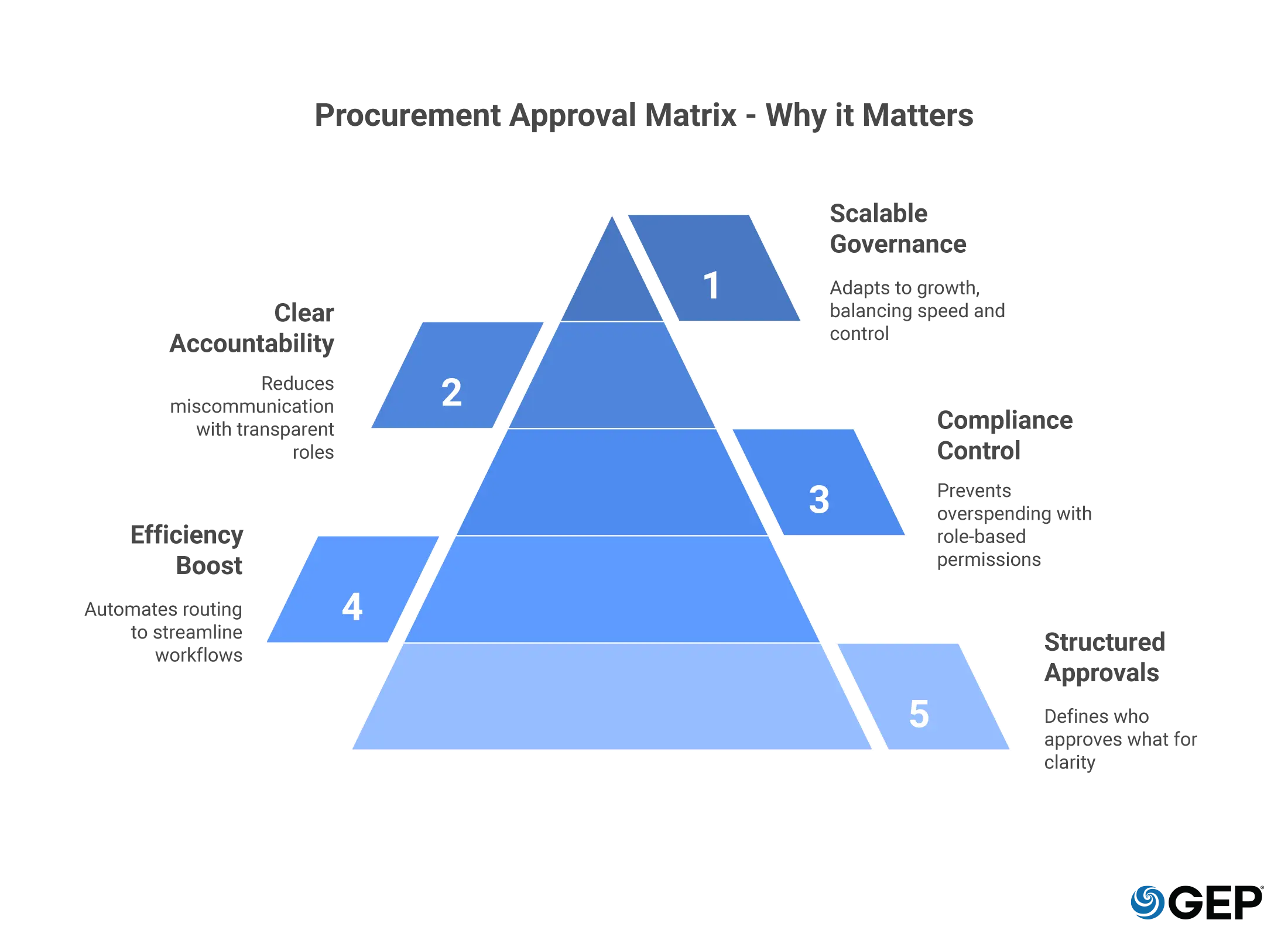
What is a Procurement Approval Matrix and How Does It Work?
- A procurement approval matrix ensures the right people approve the right purchases—without delays or confusion.
- It boosts efficiency, strengthens compliance, and makes every approval traceable and accountable.
- Automating your approval matrix saves time, reduces risk, and scales easily with your business.
September 04, 2025 | Procurement Software 4 minutes read
Procurement teams deal with constant pressure—managing budgets, chasing approvals, and keeping purchases compliant. Now imagine trying to do all that without knowing who’s supposed to sign off on what. That’s where things usually start going sideways.
Enter the procurement approval matrix—your team’s decision-making compass.
It might not sound glamorous, but this tool can save hours, prevent costly delays, and ensure accountability across every purchase. Whether you're running a small business or scaling a global operation, getting your approval process right makes all the difference.
Let’s walk through what an approval matrix is, why it matters, and how to build one that actually works in practice.
Need help automating your procurement matrix?
Explore how GEP can help automate your approval matrix—so you don’t just manage spend, you master it.
What Is an Approval Matrix?
At its core, an approval matrix is a structured table—or sometimes a workflow—that outlines who can approve what, under which circumstances. Think of it as a guide that answers questions like:
- Who approves software purchases under £1,000?
- What happens if a marketing team needs something urgently?
- Who signs off on capital expenditures over £50,000?
In procurement, the matrix helps route purchase requests to the appropriate people based on amount, department, category, or location.
Sometimes, it’s printed on a wall. More often, it lives inside approval management software, connected to your procurement tools. Either way, it simplifies the approval process and brings structure to what could otherwise become chaos.
High-growth firms fall behind without AI in procurement!
Gain expert insights into closing the AI gap and driving smarter, faster procurement decisions.
Why Companies Use an Approval Matrix (and Why You Probably Should Too)
You may be thinking, “We’ve always just emailed around for approvals—do we really need a formal matrix?”
Here’s what happens when you put one in place:
1. Workflow Efficiency Goes Up
When a request comes in, there’s no second-guessing. The system knows exactly who it needs to reach and routes it there—automatically. You’re no longer stuck tracking approvals across Slack threads or email inboxes.
And if you’ve ever waited five days for a simple yes or no, you’ll know how big a win this is.
Some companies already use automated approval workflows, which makes the process even faster and more reliable. No manual chasing. No confusion.
2. It Reduces Risk and Boosts Compliance
Without a clear structure, rogue spending becomes inevitable. A purchase approval matrix makes sure each spend goes through the right filters. Whether it’s a junior employee ordering office supplies or a department head commissioning a large vendor contract—someone accountable is always in the loop.
That’s a big deal for audits. Every decision is traceable. Every signature is logged. You’re not just staying compliant—you’re staying protected.
3. It Clears Up Miscommunication
Ever been cc’d on an email chain with 12 people where no one knows who’s approving what?
A matrix kills that confusion. Everyone sees where their authority starts and stops. Finance knows when to step in. Procurement knows when they can move forward. And department leads aren’t guessing anymore.
How an Approval Matrix Is Typically Structured
Now that we’ve talked about what it is and why it matters, let’s get into the nuts and bolts.
Tools
Some teams still use spreadsheets—and while that might work early on, most outgrow them quickly. That’s where approval management software becomes crucial.
Tools like GEP SMART can automate routing, track status, send alerts, and integrate directly with your procurement platform. It’s one less thing to manually manage—and one more way to reduce delays.
Policies
Your approval policies are the rules that govern who gets to approve what. These often include:
- Spend thresholds by role
- Department-specific rules
- Category-based approvals (like IT, marketing, or logistics)
- Urgency-based exceptions
Policies should be crystal clear—and revisited regularly as your business evolves.
Stakeholders
These are the people responsible for giving approvals. Depending on the company, this might include:
- Team leads and department heads
- Finance managers
- Procurement officers
- Executives or board members (for larger amounts)
The key is making sure these roles are clearly mapped in your matrix—so nothing falls through the cracks.
Spend Structure
How your organization manages its budget will shape your matrix. In a centralized model, approvals might all go through a single finance team. In decentralized structures, department managers may have more authority.
A good matrix reflects that reality—and avoids creating unnecessary bottlenecks.
Spend Culture
This part’s often overlooked.
Some companies value agility. Others emphasize control. Your spend culture determines whether your approval process should lean toward speed or caution.
Either way, the matrix should reflect your risk tolerance—and help strike the right balance.
Why a Procurement Approval Matrix Isn’t Just “Nice to Have”
Here’s the truth: once your company starts scaling—even modestly—the absence of a proper matrix will slow you down.
You might not notice it right away, but you’ll start seeing the signs:
- Frustrated employees waiting weeks for simple purchases
- Missed vendor deadlines due to approval confusion
- Finance teams struggling to track who approved what
These pain points add up. And in many cases, they lead to poor decisions and budget overruns.
A well-defined purchase approval matrix solves this by offering structure without adding red tape. It keeps things moving, while making sure you stay in control.
Get Everyone Onboard
procurement approval matrix might not be flashy—but it’s one of the most important tools your team can implement.
It helps you:
- Move faster with confidence
- Ensure compliance without micromanaging
- Assign responsibility clearly
- Create accountability across departments
- Scale your procurement operations smoothly
You don’t need to build something overly complex. Start small. Define roles. Set clear thresholds.
Automate what you can. And most importantly—make sure everyone understands how it works.
Your procurement team will thank you for it.
FAQs
What is the main purpose of an approval matrix?
It gives structure to who approves what—based on spend level, department, or purchase type—so that every transaction is accountable, traceable, and aligned with company policy.
What are the main components of an approval matrix?
A typical approval matrix includes:
- Spend thresholds and role-based permissions
- Category-specific approval paths
- Stakeholders and escalation logic
- Policies and exception rules
- Integration with approval workflow tools




